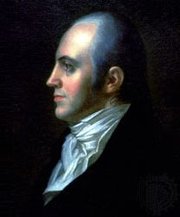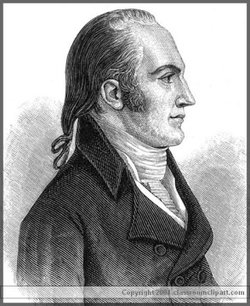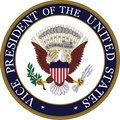Aaron Burr
|
|
Aaron Burr, Jr. (February 6, 1756–September 14, 1836) was an American politician and adventurer. He was a major formative member of the Democratic-Republican party in New York and a strong supporter of Governor George Clinton. He is remembered not so much for his tenure as the third Vice President under Thomas Jefferson as for his duel with Alexander Hamilton and his trial and acquittal on charges of treason.
| Contents [hide] |
Early life and family
Burr was born in Newark, New Jersey, to the Rev. Aaron Burr, Sr., who was the second president of the College of New Jersey, now Princeton University; his mother Esther Edwards was the daughter of Jonathan Edwards, the famous Calvinist theologian.
He originally studied theology, but abandoned it two years later and began the study of law in the celebrated law school conducted by his brother-in-law, Tapping Reeve, at Litchfield, Connecticut. His studies were put on hold for the Revolutionary War, in which he served under Benedict Arnold, George Washington and Israel Putnam.
Military service
During the American Revolutionary War, Burr accompanied Benedict Arnold's expedition into Canada in 1775, and on arriving before the Battle of Quebec, he disguised himself as a Roman Catholic priest, making a dangerous journey of 120 miles to Montreal through British lines to notify General Richard Montgomery of Arnold's arrival. Burr is said to have carried the fallen Montgomery for a short distance during the retreat from Quebec. Burr's courage earned him a place on Washington's staff, but the general never quite trusted Major Burr. However, Israel Putnam took Burr under his wing, and by his vigilance in the retreat from Long Island Burr saved an entire brigade from capture.On becoming lieutenant colonel in July 1777, he assumed the command of a regiment. During the winter at Valley Forge guarded the Gulf, a pass commanding the approach to the camp, and necessarily the first point that would be attacked. In the Battle of Monmouth (June 28, 1778) he commanded the Malcolms, a brigade in Lord Stirling's division. The Malcolms were decimated by British artillery, and Burr suffered a stroke in the terrible heat from which he would never quite recover. In January 1779, Burr was assigned to the command of the lines of Westchester County, a region between the British post at Kingsbridge and that of the Americans about 15 miles to the north. In this district there was much turbulence and plundering by the lawless elements of both Whigs and Tories, and by bands of ill-disciplined soldiers from both armies. Burr established a thorough patrol system, rigorously enforced martial law, and quickly restored order. He resigned from the army in March 1779 on account of ill health, renewing his study of law. Burr did perform occasional intelligence missions for Revolutionary generals such as Arthur St. Clair, and he rallied a group of Yale students at New Haven, where Benedict Arnold led a British assault in 1780. Burr was admitted to the bar at Albany in 1782, and began to practice in New York City after its evacuation by the British in the following year.
Marriage
That same year, Burr married Theodosia Bartow Prevost, the widow of a British army officer who had died in the West Indies during the American Revolutionary War. They had two daughters. While their younger daughter, Sarah, died at age three, their older daughter Theodosia, born in 1783, became widely known for her beauty and accomplishments. She married Joseph Alston of South Carolina in 1801, and died in a shipwreck off the Carolinas in the winter of 1812 or early 1813. Aaron Burr and his first wife were married for twelve years, until her death from cancer.
In 1833, he married again, this time to Eliza Bowen Jumel, the widow of Stephen Jumel. When she realized her fortune was dwindling from her husband's land speculation, they separated after only four months. During the month of their first anniversary, she sued for divorce, citing infidelity (Burr was in his eighties), which was granted on the day of his death. Those papers were served to Burr on his deathbed by Alexander Hamilton's elder son, whose father Burr killed in a famous duel, an irony which was hopefully not lost on the younger Hamilton.
Legal and early political career
Burr's main rival for dominance of the New York bar was Alexander Hamilton. He served in the New_York_State_Assembly from 1784 to 1785, but Burr became seriously involved in politics in 1789, when George Clinton appointed him Attorney General of New York. He was commissioner of Revolutionary claims in 1791, and that same year he defeated a favored candidate -- Alexander Hamilton's father-in-law, General Philip Schuyler -- for a seat in the United States Senate, and served in the upper house of the US Congress until 1797.
Although Hamilton and Burr had been on good personal terms, often dining with one another, Burr's defeat of General Schuyler marks the beginning of their personal quarrel. Hamilton felt Burr?s victory to be tantamount to betrayal, although some have argued that Burr did not seek the senatorial nomination. Nevertheless, Hamilton masked his hatred of Burr for a decade, remaining outwardly friendly toward his rival.
As a Senator, Burr continued to fall from grace in Washington. He sought to write an official Revolutionary history, but President Washington blocked Burr's access to the archives, possibly because the former colonel had been a noted critic of his leadership. Washington also passed Burr over for the ministry to France, and turned down his application for a brigadier's commission during the quasi-war with France in 1798 Some have speculated that Hamilton played a role in these decisions.
Burr was not reelected to the Senate in 1797, and instead went into the New York state legislature, serving from 1798 through 1801. During John Adams' term, national parties became clearly defined. Burr loosely associated himself with the Democratic-Republicans, though he had moderate Federalist allies, such as Sen. Jonathan Dayton of New Jersey. Burr quickly became a key player in New York politics, more powerful than Hamilton, largely because of the Tammany Society, later to become the infamous Tammany Hall, which Burr converted from a social club into a political machine.
As a curious side note, during the French Revolution, diplomat Charles Maurice de Talleyrand, in need of sanctuary to escape the Terror, stayed in Burr's home in New York City. Later, when Burr fled the United States after the Hamilton duel and treason trial, Talleyrand refused him entrance into France. Talleyrand had been an ardent admirer of Alexander Hamilton.
Vice Presidency
Because of his control of the crucial New York legislature, Burr was placed on the Democratic-Republican presidential ticket in the 1800 election against Thomas Jefferson. At the time, state legislatures elected the electors to the U.S. Electoral College, and New York was crucial to Jefferson. Though Jefferson did win New York and the election, so did Burr; they tied with 73 electoral votes each.
It was well understood that the party intended that Jefferson should be president and Burr vice-president, but owing to a defect (later remedied) in the U.S. Constitution, the responsibility for the final choice was thrown upon the House of Representatives. The attempts of a powerful faction among the Federalists to secure the election of Burr failed, partly because of the opposition of Alexander Hamilton and partly, it would seem, because Burr himself made no efforts to obtain votes in his own favor. Ultimately, the election devolved to the point where it took three days and 36 ballots for Burr?s moderate Federalist supporters to concede his defeat.
Upon confirmation of Jefferson?s election, Burr became Vice-President. His fair and judicial manner as president of the Senate, recognized even by his bitterest enemies, fostered traditions in regard to that position. However, Burr's refusal to give the victory to Jefferson as he had promised would cost him the trust of his own party and of Jefferson: for the rest of the administration, Burr remained an outsider.
The duel
Hamilton-burr-duel.jpg
Because Jefferson dropped Burr from his ticket in the 1804 election, the former vice-president ran for the governorship of New York instead. Burr lost the election due to a personal smear campaign orchestrated by his own party rivals, the Clintons of New York. Alexander Hamilton also opposed Burr, on the debatable grounds his rival had entertained a Federalist secession movement in New York. But Hamilton exceeded himself at one political dinner, where he expressed a "still more despicable opinion" of Burr. Novelist Gore Vidal speculated Hamilton might have accused Burr of having an incestuous relationship with his daughter Theo, but most historians discount this as fiction. After a letter regarding the incident written by Dr. Charles D. Cooper circulated in a local newspaper, Burr sought an explanation from his erstwhile friend.
Hamilton had written so many letters, and made so many private tirades against Burr, that he could not reliably comment on Cooper's vaguely worded statement. Burr demanded that Hamilton recant or deny everything he had ever said regarding Burr?s character, but Hamilton, having already been disgraced by the Maria Reynolds scandal, could not afford to make this gesture. Burr responded with a challenge to a duel, which Hamilton accepted. Both men had been noted duelists in the past, but Hamilton had qualms because his beloved son, Philip, had rashly entered into a fatal duel in 1802. They would use the same pistols, owned by Hamilton's brother-in-law, and now preserved by JPMorgan Chase & Co.
On July 11, 1804, Aaron Burr shot and fatally wounded Hamilton in their duel in Weehawken, New Jersey. The bullet entered Hamilton below the chest, and he died the following day. Some have debated who fired first; Hamilton's shot went upward and to Burr's right, striking a tree branch. Burr later learned that Hamilton intended to hold his fire during the duel. His response: "Contemptible, if true." Burr was later charged with murder in New York and New Jersey, but was not tried in either jurisdiction. He escaped to South Carolina, where his daughter lived with her family, but soon returned to Washington, D.C. to complete his term of service as Vice President. He presided over the Samuel Chase hearing with the "impartiality of an angel and the rigor of a devil." Aaron Burr's heart-felt farewell speech in March 1805 moved some of his harshest critics in the Senate to tears.
Conspiracy and trial
After the expiration of his term as Vice President on March 4, 1805, broken in fortune and virtually an exile from New York, Burr fled to Philadelphia. There he met Jonathan Dayton, with whom he created a conspiracy, the goal of which is unclear. At its grandest, the plan may have been for Burr to make a massive new nation in the west, forged from conquered provinces of Mexico and the states west of the Appalachian Mountains. Burr was to have been the leader of this Southwestern republic. Burr's dream was to create a Latin American empire that could control much of the farms and commerce of North America. Had he suceeded, the United States could have fallen into a full-scale civil war.
General James Wilkinson, a conspirator in the secret pay of Spain, had his own reasons for aiding the Burr conspiracy. As territorial governor of Louisiana, he could have seized power for himself, as he had attempted in earlier plots in Kentucky. Burr enlisted Wilkinson and others to his plan in a reconnaissance mission to the West in April 1805.
Another member of the Burr conspiracy was the Anglo-Irish aristocrat Harman Blennerhassett. After marrying his niece, Blennerhassett had been forced out of Ireland. He came to live as a quasi-feudal lord, owning an island now bearing his name on the Ohio River. It was there that he met Burr and agreed to help finance the imperial ambitions of Burr's group.
Burr may have anticipated a war with Spain, a distinct possibility had someone other than Wilkinson commanded U.S. troops on the Louisiana border. In case of a war declaration, Andrew Jackson stood ready to help Colonel Burr, who had purchased land shares from the Bastrop Grant in Texas. His expedition of perhaps eighty men carried modest arms for hunting, and no war materiel ever came to light, even when Blennerhassett Island was seized by Ohio militia.
After a near-incident with Spanish forces at Natchitoches, Wilkinson decided he could best serve his conflicting interests by betraying Burr's plans to President Jefferson — and his Spanish paymasters. Jefferson's passivity throughout most of 1806 remains baffling to this day, but he finally issued a proclamation for Burr's arrest. Burr read this in a newspaper in the Orleans Territory on January 10, 1807. He turned himself in to the authorities, but soon jumped bail and fled for Spanish Florida; he was intercepted in Alabama on February 19, 1807.
Burr's secret correspondence with Anthony Merry and the Carlos Mart�z de Irujo y Tacó®¼arquis of Casa Yrujo, the British and Spanish ministers at Washington, had been, it would seem, to secure money and to conceal his real designs, which were probably to overthrow Spanish power in the Southwest, and perhaps to found an imperial dynasty in Mexico. This seems to have been a misdemeanor, based on the Neutrality_Act passed to block filibuster expeditions like those questionable enterprises of George Rogers Clark and William Blount. But Jefferson sought the highest charges against his former lieutenant, even though his informant Wilkinson was notoriously corrupt.
In 1807, on charge of treason, Burr was brought to trial before the United States circuit court at Richmond, Virginia. His defense lawyer was Luther Martin. Burr was arraigned four times for treason before a grand jury; the fourth time, May 22, sufficient evidence was found to indict him. His trial, which was run by Chief Justice John Marshall, began August 3.
Due to lack of the constitutionally required two witnesses, Burr was acquitted on September 1, in spite of the fact that the full force of the political influence of the national administration had been thrown against him. Immediately afterwards, he was tried on a more believable charge of misdemeanor, but was again acquitted on a technicality.
Later life
At this point all hopes for a political comeback had been dashed, and Burr fled America and his creditors for Europe, where he tried to regain his fortunes. He lived abroad from 1808 to 1812, passing most of his time in England, Scotland, Denmark, Sweden and France. He tried to secure aid in the prosecution of his filibustering schemes but met with numerous rebuffs. He was ordered out of England and Napoleon Bonaparte refused to receive him.
He returned quietly to New York in 1812, intending to visit his daughter, but the ship his daughter had been traveling in from South Carolina was lost at sea with all of Burr's important papers. Burr lived in New York as a moderately successful attorney until his death at Port Richmond, Staten Island, New York in 1836. He maintained an interest in Western expansion until his death, and he lived to see the Texas Revolution. He noted with pleasure: "What was treason in me thirty years ago, is patriotism now."
Character and miscellany
Burr could be unscrupulous, insincere and somewhat amoral, but towards his friends he could be pleasing in his manners and generous to a fault. Although he proved irresistible to many women, few historians doubt Burr?s devotion to his wife and daughter. When his first wife died, Burr lost any stabilizing influence he had in life and his character took a turn for the worse. He once said he considered it an honor if a woman claimed him as the father of her child, even if the claim were false.
Late in life, Burr reportedly went by Aaron Edwards (his mother's maiden name) because it was less associated with past scandals.
Burr by Gore Vidal is an oblique biographical take on the politician, but it should be taken as historical fiction.
Primary sources
- Full text of Memoirs of Aaron Burr from Project Gutenberg: Vol. 1 (http://www.gutenberg.net/etext/7850), Vol. 2 (http://www.gutenberg.net/etext/7851)
References
Further reading
- Lomask, Milton, "Aaron Burr," 2 Vols. New York, 1979, 1983.
- Parton, James, The Life and Times of Aaron Burr, Boston and New York, 1898. (2 vols.)
- McCaleb, W.F., The Aaron Burr Conspiracy, New York, 1903.
- I. Jenkinson, Aaron Burr, Richmond, Indiana, 1902.
- Adams, Henry, History of the United States, vol. iii. New York, 1890. (For the traditional view of Burr's conspiracy.)
External links
- The Political Graveyard: Edwards family (http://politicalgraveyard.com/families/1203.html)
- BURR, Aaron, 1756-1836: Extended Bibliography (http://bioguide.congress.gov/scripts/bibdisplay.pl?index=B001133)
| Preceded by: Philip Schuyler | U.S. Senator from New York 1791-1797 | Succeeded by: Philip Schuyler | ||||
| Preceded by: George Clinton(a) | Republican Party Vice Presidential candidate 1796 (lost)(a), 1800 (won Vice Presidency)(a) | Succeeded by: George Clinton | ||||
| Preceded by: Thomas Jefferson | Vice President of the United States March 4, 1801 – March 3, 1805 | Succeeded by: George Clinton Template:Succession footnote Template:End box
|
||||



